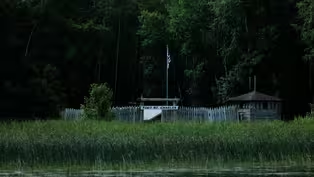Prairie Sportsman
Batteries Charged With Renewables
Clip: Season 16 Episode 4 | 8m 12sVideo has Closed Captions
Researchers investigate flow batteries for storing Minnesota’s renewable energy.
Researchers are exploring ways to store renewable energy in large-flow batteries that are made without the need to mine rare, precious metals. While Minnesota doesn’t have any coal, oil, or natural gas, the state does have an abundance of energy that comes from the sun and wind. The University of Minnesota Morris is evaluating flow batteries in the marketplace and plans to install a demonstration.
Problems playing video? | Closed Captioning Feedback
Problems playing video? | Closed Captioning Feedback
Prairie Sportsman is a local public television program presented by Pioneer PBS
Production sponsorship is provided by funding from the Environment and Natural Resources Trust Fund, West Central Initiative, Shalom Hill Farm, and members of Pioneer PBS.
Prairie Sportsman
Batteries Charged With Renewables
Clip: Season 16 Episode 4 | 8m 12sVideo has Closed Captions
Researchers are exploring ways to store renewable energy in large-flow batteries that are made without the need to mine rare, precious metals. While Minnesota doesn’t have any coal, oil, or natural gas, the state does have an abundance of energy that comes from the sun and wind. The University of Minnesota Morris is evaluating flow batteries in the marketplace and plans to install a demonstration.
Problems playing video? | Closed Captioning Feedback
How to Watch Prairie Sportsman
Prairie Sportsman is available to stream on pbs.org and the free PBS App, available on iPhone, Apple TV, Android TV, Android smartphones, Amazon Fire TV, Amazon Fire Tablet, Roku, Samsung Smart TV, and Vizio.

Prairie Sportsman Premium Gifts
Do you love the great outdoors, hunting, fishing, hiking and conservation? Consider becoming a friend of Prairie Sportsman to support it and receive gifts with your contribution.Providing Support for PBS.org
Learn Moreabout PBS online sponsorship(intriguing suspenseful music) - [Bret] Minnesota doesn't have any fossil fuels, no coal, no oil, no natural gas.
But what we do have is an abundance of renewable energy from the sun and the wind.
Researchers are looking at ways to store that energy in huge batteries that are made without the need to mine rare precious metals.
(intriguing dramatic music) - What we have is abundant clean energy in Minnesota.
And so, that could be a economic engine for our state.
15 years ago, it wasn't entirely how we would get to put s much green energy on the grid.
Now we're there.
We're cracking the electricity code, but it's gonna require a lot of storage as well.
- The project that we're working on is a large battery storage project, is a large battery storage project, and it is in partnership with Otter Tail Power Company and OATI, a Minnesota- based company.
The project started after a trip that my colleague, Troy Goodnough, and I took in 2016 with other people from the University of Minnesota and other leaders from the state.
We went to look at batter storage technology in California - California set ambitious electricity goals years ago, and they've blown through all those goals, they've just conquered that mountain, and really changed thei electricity system with storage.
We forget how familiar we are with energy storage already in our lives, and especially like lithium-ion storage as people are talking about EV cars and whether they're pro or against them.
If you've got a mobile phone in your pocket and you use a computer every day, you're already very familiar with lithium-ion technology.
It's ubiquitous, it's what we use.
We see China has invested a lot in energy storage technologies.
They really own the lithium-ion battery storage space.
(intriguing orchestral music) - [Bret] In 2021, th University of Minnesota Morris received a grant from the Environment Natural Resources Trust Fund to study flow battery technologies as an alternative to lithium-ion - Lithium-ion and other batteries, like, that do require rare Earth metals that are harder to obtain, we were looking at this as an opportunity to lessen the environmental impact of a battery.
Most of these materials are easily recyclable, so you will be using chemistry that is not hard to mine.
For example, some of th batteries we looked at are iron, iron is the most commonly occurring mineral particularly in Minnesota, or vanadium, which is als very commonly occurring metal, or some of the othe chemistries that are coming out.
And so, to be able to use something that is more common doesn't require the mining impacts.
- [Troy] You've got two tanks of liquid, you've got a positive and negative tank, you've got a membrane, and if you are clever, the way you flow those liquids, you can pull electrons out of them.
- The huge benefit to a flow battery is you don't have a degradation like you do with a lithium-ion battery.
Lithium-ion battery, your cell phone, after a couple of years, does not retain the same amount of charge.
This one, we have unlimited cycling, so it can use it multiple times a day, and it shouldn't really ever have less storage capacity.
And so, the opportunity to keep it 20, 25, 30 years is very, very high potential.
If you think of a cell phone, when it's really cold, it doesn't work the same, right?
And if it's really hot, it doesn't work the same.
So you have to kind of keep it within kind of the operating ranges that are good.
A full battery, you should not have to worry about that, because, it, typically, depending on the chemistry, doesn't require the amount of HVAC controls that you would for a lithium-ion battery storage of that size.
- [Bret] Although flow batteries have been developed on the East and West Coasts, there are none in the Upper Midwest.
University researchers are looking at various flow batteries in the marketplace and plan to install demonstration battery on campus.
- The University of Minnesota Morris, we have been a leader and we wanna continue to be a leader in this area.
- Our campus is carbon neutral.
We've got two large wind turbine which provide over 60% of our electricity.
- We're looking at a projec that would be about a megawatt.
So our campus uses about a megawatt of power on a normal day when it's not too hot or too cold.
- We're a million square foot campus, right?
We're essentially a city within the city of Morris.
So this really like provides big opportunities for rural communities.
- [Bret] Flow batteries are not small enough for homes or vehicles, but they can provide energy to a grid.
- Otter Tail Power Company will be the operator of it, and so it'll be connected to their grid.
They have a large footprint, and they have lots of small towns that they support.
And so, thinking about ways that this could potentially go for them to be able to help meet some of the energy demands more locally.
- These solutions solve two issues.
They both drive economi development with what we have, which is wind, solar, and great soil, and it helps address some of the environmental challenges that we're facing too.
- It's an opportunity for our students to be able to learn, and that's a benefit of our campuses.
We have opportunities for our st to be able to engage and work on some of these projects and be able to be a part of a large project like this that will be the first of its kind and definitely in the Upper Midwest.
We are hoping that this will be a place for other utilities to learn.
One of the things that we have learned through this process is people really wanna be able to see things and see how they work.
And that's what we want to be is that place to be able to say, "You wanna come and learn about this?
Come here."
You can see it, and we're gonna be able to tell you the things that are working, the things that are not working, and the things that we're learning from this.
- If you live here, you know it's windy in Western Minnesota, and you know it's sunny.
These are assets.
And so, I'm excited about us harnessing these assets to meet the human needs that we have in the region.
We're talking about batteries that require tanks of liquid, pumps, valves, membranes, all kinds of things that ou companies can make right here.
We think that these new technologies for stationary storage are gonna just become commonplace.
- I could see large commercial or industrial companies or manufacturers or other groups of people that could get together and use renewables and partner with battery power and battery storage to be able to utilize that in whatever process they need.
(techno orchestral music) There is some cost savings that we will likely see as the technology develops.
When West Central Research and Outreach Center in the University of Minnesota Morris partnered to install the first wind turbine, it was expensive.
When you put in the second one in 2011, it was still.
Now you see lots of wind turbines.
It's pretty standard, they know how to do the project, they knew how to do the process.
I see battery storage, in the next 10 to 15 years, you will see the same thing, you'll see the same development.
It's just like any cost curve.
The cost curve will come down.
And we feel with minerals that are not rare Earth minerals, that are harder to mine, the cost curve can come down faster.
For example, iron, it's ver abundant and very easy to get.
That could get the cost curve down very quickly.
- As we drive around rural Minnesota, we see storage everywhere, right?
So we harvest grain, we store it in containers.
The energy revolution we're talking about right now is just tanks of water with some stuff in it.
And we can store huge amounts of energy.
Battery storage, the way we're talking about, flow battery storage, is just gonna be part of a well-balanced energy storage diet.
We see economic development here, right?
We want our kids and grandkids to be able to have good paying jobs in our region.
We do believe this has transformative potential.
Driving around rural areas and seeing tanks of liquid that have huge amounts of electricity stored in them, that's transformative.
(techno orchestral music)
Lighthouse Boats and Storing Renewable Energy
Video has Closed Captions
Preview: S16 Ep4 | 30s | Explore outdoor recreation provided by Minnesota water areas and researchers test flow batteries. (30s)
Video has Closed Captions
Clip: S16 Ep4 | 17m 47s | Host Bret Amundson takes viewers on a tour of the historic Northwest Angle. (17m 47s)
Providing Support for PBS.org
Learn Moreabout PBS online sponsorship
- Science and Nature

Explore scientific discoveries on television's most acclaimed science documentary series.

- Science and Nature

Capturing the splendor of the natural world, from the African plains to the Antarctic ice.












Support for PBS provided by:
Prairie Sportsman is a local public television program presented by Pioneer PBS
Production sponsorship is provided by funding from the Environment and Natural Resources Trust Fund, West Central Initiative, Shalom Hill Farm, and members of Pioneer PBS.



